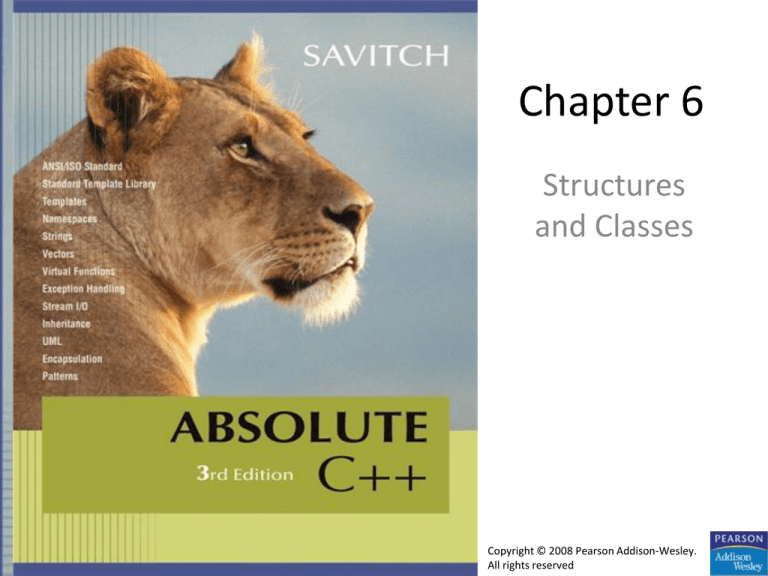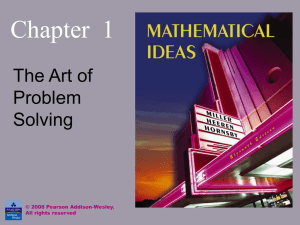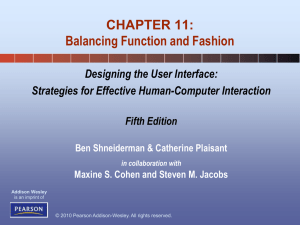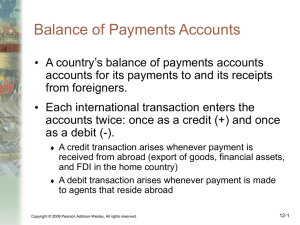
Chapter 6
Structures
and Classes
Copyright © 2008 Pearson Addison-Wesley.
All rights reserved
Learning Objectives
• Structures
– Structure types
– Structures as function arguments
– Initializing structures
• Classes
–
–
–
–
Defining, member functions
Public and private members
Accessor and mutator functions
Structures vs. classes
Copyright © 2008 Pearson Addison-Wesley. All rights reserved.
6-2
Structures
• 2nd aggregate data type: struct
• Recall: aggregate meaning "grouping"
– Recall array: collection of values of same type
– Structure: collection of values of different types
• Treated as a single item, like arrays
• Major difference: Must first "define" struct
– Prior to declaring any variables
Copyright © 2008 Pearson Addison-Wesley. All rights reserved.
6-3
Structure Types
• Define struct globally (typically)
• No memory is allocated
– Just a "placeholder" for what our struct
will "look like"
• Definition:
struct CDAccountV1 Name of new struct "type"
{
double balance;
member names
double interestRate;
int term;
};
Copyright © 2008 Pearson Addison-Wesley. All rights reserved.
6-4
Declare Structure Variable
• With structure type defined, now declare
variables of this new type:
CDAccountV1 account;
– Just like declaring simple types
– Variable account now of type CDAccountV1
– It contains "member values"
• Each of the struct "parts"
Copyright © 2008 Pearson Addison-Wesley. All rights reserved.
6-5
Accessing Structure Members
• Dot Operator to access members
– account.balance
– account.interestRate
– account.term
• Called "member variables"
– The "parts" of the structure variable
– Different structs can have same name
member variables
• No conflicts
Copyright © 2008 Pearson Addison-Wesley. All rights reserved.
6-6
Structure Example:
Display 6.1 A Structure Definition (1 of 3)
Copyright © 2008 Pearson Addison-Wesley. All rights reserved.
6-7
Structure Example:
Display 6.1 A Structure Definition (2 of 3)
Copyright © 2008 Pearson Addison-Wesley. All rights reserved.
6-8
Structure Example:
Display 6.1 A Structure Definition (3 of 3)
Copyright © 2008 Pearson Addison-Wesley. All rights reserved.
6-9
Structure Pitfall
• Semicolon after structure definition
– ; MUST exist:
struct WeatherData
{
double temperature;
double windVelocity;
}; REQUIRED semicolon!
– Required since you "can" declare structure
variables in this location
Copyright © 2008 Pearson Addison-Wesley. All rights reserved.
6-10
Structure Assignments
• Given structure named CropYield
• Declare two structure variables:
CropYield apples, oranges;
– Both are variables of "struct type CropYield"
– Simple assignments are legal:
apples = oranges;
• Simply copies each member variable from apples
into member variables from oranges
Copyright © 2008 Pearson Addison-Wesley. All rights reserved.
6-11
Structures as Function Arguments
• Passed like any simple data type
– Pass-by-value
– Pass-by-reference
– Or combination
• Can also be returned by function
– Return-type is structure type
– Return statement in function definition
sends structure variable back to caller
Copyright © 2008 Pearson Addison-Wesley. All rights reserved.
6-12
Initializing Structures
• Can initialize at declaration
– Example:
struct Date
{
int month;
int day;
int year;
};
Date dueDate = {12, 31, 2003};
– Declaration provides initial data to all three member
variables
Copyright © 2008 Pearson Addison-Wesley. All rights reserved.
6-13
Classes
• Similar to structures
– Adds member FUNCTIONS
– Not just member data
• Integral to object-oriented programming
– Focus on objects
• Object: Contains data and operations
• In C++, variables of class type are objects
Copyright © 2008 Pearson Addison-Wesley. All rights reserved.
6-14
Class Definitions
• Defined similar to structures
• Example:
class DayOfYear name of new class type
{
public:
void output(); member function!
int month;
int day;
};
• Notice only member function’s prototype
– Function’s implementation is elsewhere
Copyright © 2008 Pearson Addison-Wesley. All rights reserved.
6-15
Declaring Objects
• Declared same as all variables
– Predefined types, structure types
• Example:
DayOfYear today, birthday;
• Declares two objects of class type DayOfYear
• Objects include:
– Data
• Members month, day
– Operations (member functions)
• output()
Copyright © 2008 Pearson Addison-Wesley. All rights reserved.
6-16
Class Member Access
• Members accessed same as structures
• Example:
today.month
today.day
– And to access member function:
today.output(); Invokes member function
Copyright © 2008 Pearson Addison-Wesley. All rights reserved.
6-17
Class Member Functions
• Must define or "implement" class member
functions
• Like other function definitions
– Can be after main() definition
– Must specify class:
void DayOfYear::output()
{…}
• :: is scope resolution operator
• Instructs compiler "what class" member is from
• Item before :: called type qualifier
Copyright © 2008 Pearson Addison-Wesley. All rights reserved.
6-18
Class Member Functions Definition
• Notice output() member function’s
definition (in next example)
• Refers to member data of class
– No qualifiers
• Function used for all objects of the class
– Will refer to "that object’s" data when invoked
– Example:
today.output();
• Displays "today" object’s data
Copyright © 2008 Pearson Addison-Wesley. All rights reserved.
6-19
Complete Class Example:
Display 6.3 Class With a Member Function (1 of
4)
Copyright © 2008 Pearson Addison-Wesley. All rights reserved.
6-20
Complete Class Example:
Display 6.3 Class With a Member Function (2 of
4)
Copyright © 2008 Pearson Addison-Wesley. All rights reserved.
6-21
Complete Class Example:
Display 6.3 Class With a Member Function (3 of
4)
Copyright © 2008 Pearson Addison-Wesley. All rights reserved.
6-22
Complete Class Example:
Display 6.3 Class With a Member Function (4 of
4)
Copyright © 2008 Pearson Addison-Wesley. All rights reserved.
6-23
Dot and Scope Resolution Operator
• Used to specify "of what thing" they are
members
• Dot operator:
– Specifies member of particular object
• Scope resolution operator:
– Specifies what class the function
definition comes from
Copyright © 2008 Pearson Addison-Wesley. All rights reserved.
6-24
A Class’s Place
• Class is full-fledged type!
– Just like data types int, double, etc.
• Can have variables of a class type
– We simply call them "objects"
• Can have parameters of a class type
– Pass-by-value
– Pass-by-reference
• Can use class type like any other type!
Copyright © 2008 Pearson Addison-Wesley. All rights reserved.
6-25
Encapsulation
• Any data type includes
– Data (range of data)
– Operations (that can be performed on data)
• Example:
int data type has:
Data: +-32,767
Operations: +,-,*,/,%,logical,etc.
• Same with classes
– But WE specify data, and the operations to
be allowed on our data!
Copyright © 2008 Pearson Addison-Wesley. All rights reserved.
6-26
Abstract Data Types
• "Abstract"
– Programmers don’t know details
• Abbreviated "ADT"
– Collection of data values together with set
of basic operations defined for the values
• ADT’s often "language-independent"
– We implement ADT’s in C++ with classes
• C++ class "defines" the ADT
– Other languages implement ADT’s as well
Copyright © 2008 Pearson Addison-Wesley. All rights reserved.
6-27
More Encapsulation
• Encapsulation
– Means "bringing together as one"
• Declare a class get an object
• Object is "encapsulation" of
– Data values
– Operations on the data (member functions)
Copyright © 2008 Pearson Addison-Wesley. All rights reserved.
6-28
Principles of OOP
• Information Hiding
– Details of how operations work not known to "user" of
class
• Data Abstraction
– Details of how data is manipulated within
ADT/class not known to user
• Encapsulation
– Bring together data and operations, but keep "details"
hidden
Copyright © 2008 Pearson Addison-Wesley. All rights reserved.
6-29
Public and Private Members
• Data in class almost always designated
private in definition!
– Upholds principles of OOP
– Hide data from user
– Allow manipulation only via operations
• Which are member functions
• Public items (usually member functions)
are "user-accessible"
Copyright © 2008 Pearson Addison-Wesley. All rights reserved.
6-30
Public and Private Example
• Modify previous example:
class DayOfYear
{
public:
void input();
void output();
private:
int month;
int day;
};
• Data now private
• Objects have no direct access
Copyright © 2008 Pearson Addison-Wesley. All rights reserved.
6-31
Public and Private Example 2
• Given previous example
• Declare object:
DayOfYear today;
• Object today can ONLY access
public members
– cin >> today.month; // NOT ALLOWED!
– cout << today.day; // NOT ALLOWED!
– Must instead call public operations:
• today.input();
• today.output();
Copyright © 2008 Pearson Addison-Wesley. All rights reserved.
6-32
Public and Private Style
• Can mix & match public & private
• More typically place public first
– Allows easy viewing of portions that can be
USED by programmers using the class
– Private data is "hidden", so irrelevant to users
• Outside of class definition, cannot change
(or even access) private data
Copyright © 2008 Pearson Addison-Wesley. All rights reserved.
6-33
Accessor and Mutator Functions
• Object needs to "do something" with its data
• Call accessor member functions
– Allow object to read data
– Also called "get member functions"
– Simple retrieval of member data
• Mutator member functions
– Allow object to change data
– Manipulated based on application
Copyright © 2008 Pearson Addison-Wesley. All rights reserved.
6-34
Separate Interface
and Implementation
• User of class need not see details of how
class is implemented
– Principle of OOP encapsulation
• User only needs "rules"
– Called "interface" for the class
• In C++ public member functions and
associated comments
• Implementation of class hidden
– Member function definitions elsewhere
– User need not see them
Copyright © 2008 Pearson Addison-Wesley. All rights reserved.
6-35
Structures versus Classes
• Structures
– Typically all members public
– No member functions
• Classes
– Typically all data members private
– Interface member functions public
• Technically, same
– Perceptionally, very different mechanisms
Copyright © 2008 Pearson Addison-Wesley. All rights reserved.
6-36
Thinking Objects
• Focus for programming changes
– Before algorithms center stage
– OOP data is focus
• Algorithms still exist
– They simply focus on their data
– Are "made" to "fit" the data
• Designing software solution
– Define variety of objects and how they interact
Copyright © 2008 Pearson Addison-Wesley. All rights reserved.
6-37
Summary 1
• Structure is collection of different types
• Class used to combine data and functions
into single unit -> object
• Member variables and member functions
– Can be public accessed outside class
– Can be private accessed only in a member
function’s definition
• Class and structure types can be formal
parameters to functions
Copyright © 2008 Pearson Addison-Wesley. All rights reserved.
6-38
Summary 2
• C++ class definition
– Should separate two key parts
• Interface: what user needs
• Implementation: details of how class works
Copyright © 2008 Pearson Addison-Wesley. All rights reserved.
6-39








